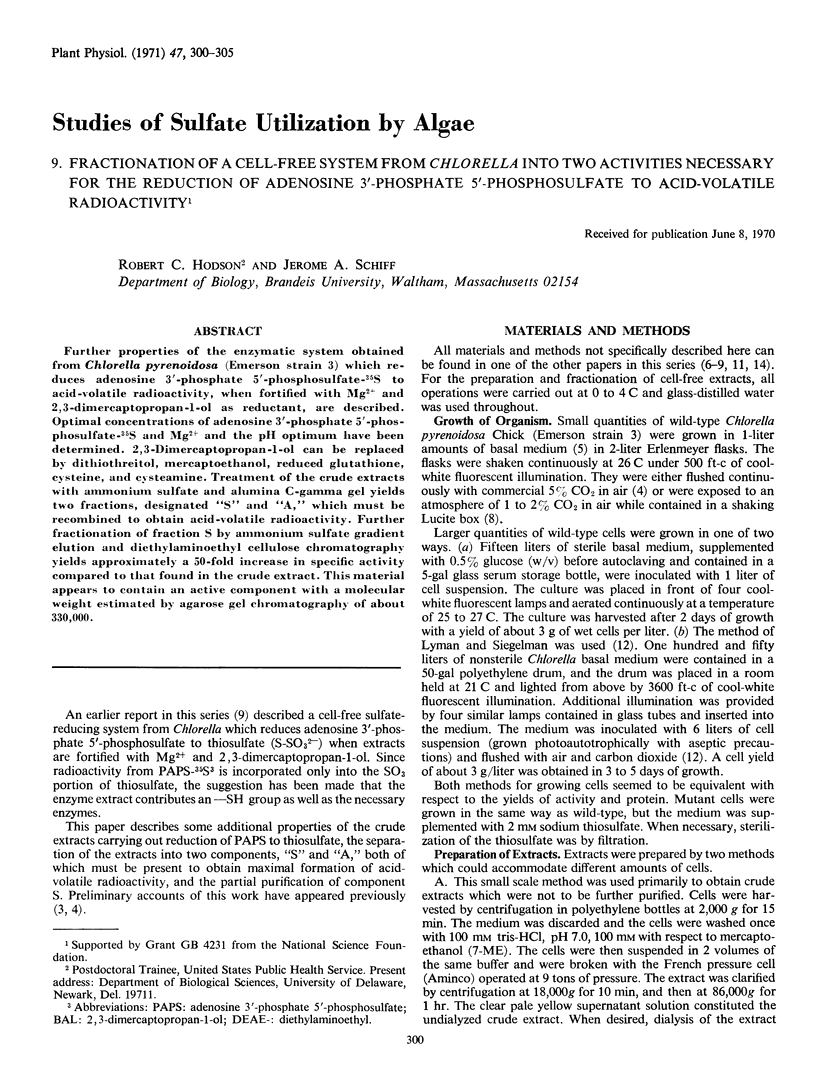Abstract
Further properties of the enzymatic system obtained from Chlorella pyrenoidosa (Emerson strain 3) which reduces adenosine 3′-phosphate 5′-phosphosulfate-35S to acid-volatile radioactivity, when fortified with Mg2+ and 2, 3-dimercaptopropan-1-ol as reductant, are described. Optimal concentrations of adenosine 3′-phosphate 5′-phosphosulfate-35S and Mg2+ and the pH optimum have been determined. 2,3-Dimercaptopropan-1-ol can be replaced by dithiothreitol, mercaptoethanol, reduced glutathione, cysteine, and cysteamine. Treatment of the crude extracts with ammonium sulfate and alumina C-gamma gel yields two fractions, designated “S” and “A,” which must be recombined to obtain acid-volatile radioactivity. Further fractionation of fraction S by ammonium sulfate gradient elution and diethylaminoethyl cellulose chromatography yields approximately a 50-fold increase in specific activity compared to that found in the crude extract. This material appears to contain an active component with a molecular weight estimated by agarose gel chromatography of about 330,000.
Full text
PDF





Selected References
These references are in PubMed. This may not be the complete list of references from this article.
- Andrews P. The gel-filtration behaviour of proteins related to their molecular weights over a wide range. Biochem J. 1965 Sep;96(3):595–606. doi: 10.1042/bj0960595. [DOI] [PMC free article] [PubMed] [Google Scholar]
- Hodson R. C., Schiff J. A., Mather J. P. Studies of sulfate utilization by algae: 10. Nutritional and enzymatic characterization of chlorella mutants impaired for sulfate utilization. Plant Physiol. 1971 Feb;47(2):306–311. doi: 10.1104/pp.47.2.306. [DOI] [PMC free article] [PubMed] [Google Scholar]
- Hodson R. C., Schiff J. A. Preparation of adenosine-3'-phosphate-51-phosphosulfate (PAPS): an improved enzymatic method using Chlorella pyrenoidosa. Arch Biochem Biophys. 1969 Jun;132(1):151–156. doi: 10.1016/0003-9861(69)90347-6. [DOI] [PubMed] [Google Scholar]
- Hodson R. C., Schiff J. A., Scarsella A. J., Levinthal M. Studies of Sulfate Utilization by Algae. 6. Adenosine-3'-Phosphate-5'-Phosphosulfate (PAPS) as an Intermediate in Thiosulfate Formation From Sulfate by Cell-Free Extracts of Chlorella. Plant Physiol. 1968 Apr;43(4):563–569. doi: 10.1104/pp.43.4.563. [DOI] [PMC free article] [PubMed] [Google Scholar]
- Hodson R. C., Schiff J. A., Scarsella A. J. Studies of Sulfate Utilization by Algae. 7. In vivo Metabolism of Thiosulfate by Chlorella. Plant Physiol. 1968 Apr;43(4):570–577. doi: 10.1104/pp.43.4.570. [DOI] [PMC free article] [PubMed] [Google Scholar]
- Hodson R. C., Schiff J. A. Studies of sulfate utilization by algae: 8. The ubiquity of sulfate reduction to thiosulfate. Plant Physiol. 1971 Feb;47(2):296–299. doi: 10.1104/pp.47.2.296. [DOI] [PMC free article] [PubMed] [Google Scholar]
- Levinthal M., Schiff J. A. Studies of sulfate utilization by algae. 5. Identification of thiosulfate as a major Acid-volatile product formed by a cell-free sulfate-reducing system from chlorella. Plant Physiol. 1968 Apr;43(4):555–562. doi: 10.1104/pp.43.4.555. [DOI] [PMC free article] [PubMed] [Google Scholar]
- Lyman H., Siegelman H. W. Large-scale autotrophic culture of Euglena gracilis. J Protozool. 1967 May;14(2):297–299. doi: 10.1111/j.1550-7408.1967.tb02000.x. [DOI] [PubMed] [Google Scholar]
- Schiff J. A., Levinthal M. Studies of sulfate utilization by algae. 4. Properties of a cell-free sulfate-reducing system from chlorella. Plant Physiol. 1968 Apr;43(4):547–554. doi: 10.1104/pp.43.4.547. [DOI] [PMC free article] [PubMed] [Google Scholar]


